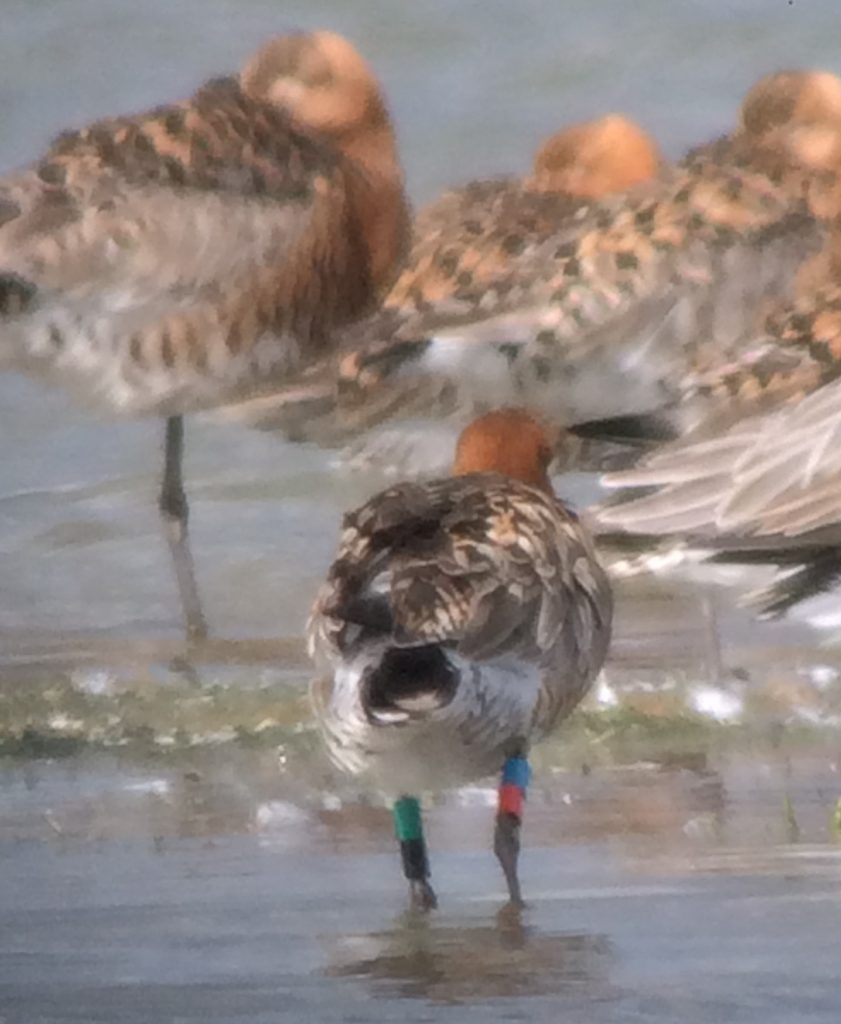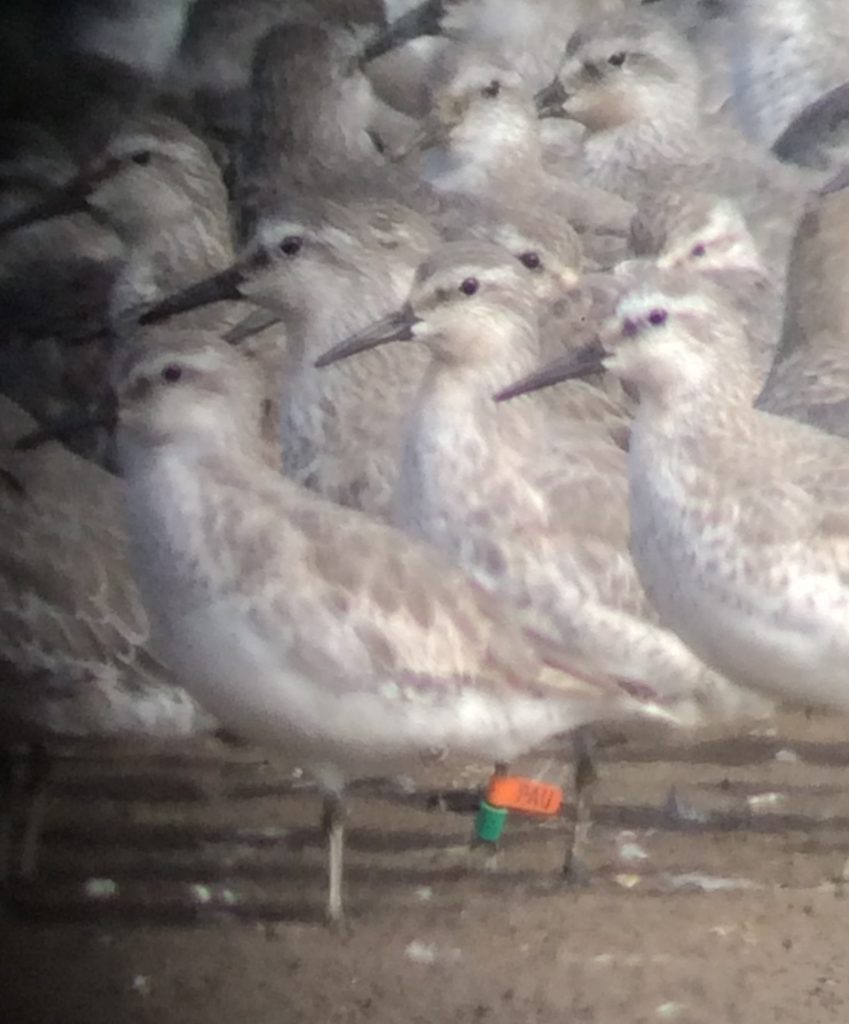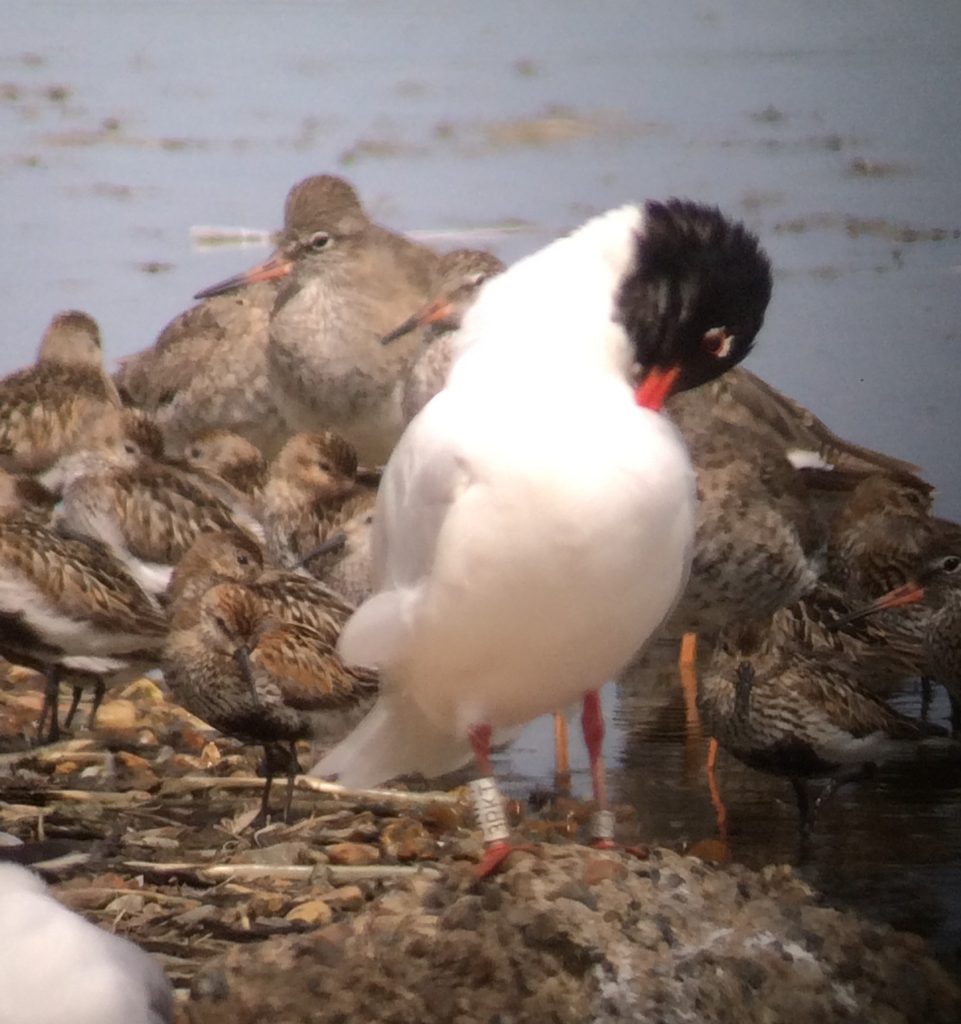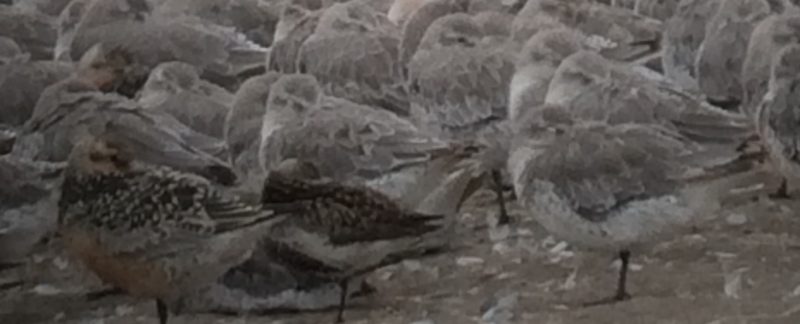The lockdown imposed by the government in response to the Covid-19 pandemic lasted seven weeks during which fieldwork, including ringing and re-sighting, across the UK came to a standstill. WWRG had just completed their winter field work with the final catching weekend of the season having taken place in mid-March. Trips for several members of WWRG to Delaware and to Iceland were cancelled and opportunities for re-sighting on the Wash were all curtailed during the final weeks of spring 2020 as we were all told to stay at home. Garden ringing and local walks (hopefully entered into Birdtrack) became the norm.
The easing of lockdown restrictions in mid-May opened a window to enable the first trips to the Wash for re-sighting. Most of the WWRG colour-marked Curlew, Bar-tailed Godwit, Grey Plover and Turnstone had left on their journeys north to the breeding grounds so we decided to focus our efforts on trying to locate any late migrants passing through the Wash. We knew that one species to look for was the late peak of Bar-tailed Godwits which winter in West Africa and are known to pass through south-eastern England in late April and early May (ssp taymarensis). May 12th is apparently known as ‘Godwit Day’ at Breydon Water due to the regularity of this passage (Wernham et al 2002). We wondered whether some of these birds might also stage on the Wash at this time.
Our first post-lockdown outing was unfortunately already passed the optimum time to find the Bar-tailed Godwit but we considered that it was worth a go. So, on 17th May we headed to Holme-next-the-Sea where we found 11 Knot (seven second calendar year (2cy) birds and four adults) on the beach at high tide along with just two Bar-tailed Godwit, both probably 2cy birds as they were in non-breeding plumage. There were several flocks of Grey Plover (mainly in breeding plumage) and Knot flying around offshore as though heading for a roost site to the south, possibly into the Wash. We also looked at Heacham NN beach on the falling tide and found six Turnstone, one of which was a WWRG colour-marked bird. This turned out to be one of the Turnstone ringed on 15th March, in the last catching weekend.
A few days later, 21st May found us on Snettisham beach where a mixed flock of Sanderling, Dunlin and Ringed Plover were found on the beach and a flock of around 1,000 Knot out on the mudflats (mainly 2cy birds) with over 100 Grey Plover (in breeding plumage). There were no Curlew or Bar-tailed Godwit seen.

A further trip on 28th May to Snettisham and Heacham resulted in a flock of around 300 Sanderling in spectacular breeding plumage. The group included two colour-marked birds, one ringed on Arquipelago dos Bijagos in Guinea Bissau on 19th November 2019 and the other in East Greenland on 15th July 2019, so one bird ringed on the wintering ground and another in the breeding area. (The bird ringed in Guinea Bissau has recently been seen again, by Chris Kelly, on 24th July 2020 on its return migration). There were 33 2cy Knot on the mussel beds out from Heacham dam, none of which were ringed.
A visit to RSPB Snettisham on 7th June found two colour-marked Avocet (both ringed in France), four Curlew (none with flags) and 12 Sanderling, all on the mudflats. The Avocets were probably part of the breeding flock on the pits at Snettisham. The hides at Snettisham were all closed at this time due to Covid-19, significantly reducing opportunities to search the pits for colour-marked waders.
On 13th June, we ventured further round the coast to Thornham and RSPB Titchwell at high tide. No waders were found between Thornham and Old Hunstanton with a flock of 170 Knot, 80 Bar-tailed Godwit and 60 Black-tailed Godwit at Titchwell. The only colour-mark was a Black-tailed Godwit with faded colours that made it impossible to read.
A return visit to RSPB Titchwell on 26th June found similar numbers of birds as previously, including 170 Knot, 75 Bar-tailed Godwit and around 80 Black-tailed Godwit (no colour-marks). In addition, there were 10 Curlew and many Avocet, two of which were ringed, both from France. We also visited Snettisham and, although no colour-marked waders, we found a Sandwich Tern, ringed on Inner Farne in 2015 and a Common Gull, ringed in Norway.
Occasionally, there is the opportunity to catch summering Knot during the WWRG annual maintenance trip in early July although this has not been possible for the last few years. Flocks of c. 1,000 Knot had been seen flying to roost on our trips but we hadn’t found the roost, (this was made more difficult by the closure of the Snettisham reserve at this time). Re-sighting by people in NW England had located several thousand Knot in early June but, from the 2,000 2cy Knot they were able to sight, only one colour-marked bird was found, a bird ringed in Bangor in January 2020. There was interest from this group as to the whereabouts of the Knot caught and colour-marked in Dublin and Bangor last winter. It seemed that these birds were not on Merseyside and there was therefore the possibility that these birds could be summering on the Wash.

With little success in our search for Knot on the Norfolk side of the Wash, we decided to venture to the Lincolnshire side. There were a couple of records of Knot flocks of up to 1,000 birds on Birdtrack which seemed helpful and then an email exchange with Steve Dodd alerted us to a large flock at RSPB Frampton (posted on 27th June). Using the WWRG fieldwork house as a base, we visited RSPB Frampton on 6th and 7th July where we found a Knot flock of up to 12,000, 90% of which were 2cy birds, roosting on the sand banks east of the sea wall. We found that we were not alone in our quest with Peter Knight and Rose Maciewicz, re-sighters from the NW, coincidentally being at Frampton on the same day. Several hours of patiently watching this flock resulted in sightings of three flagged birds, one ringed in Bangor, one on the Humber estuary and one in Ireland.
Gratefully accepting the offer of a house swap for a week in mid-July from our daughter, who lives in Norfolk, we had the opportunity our first ‘holiday’ in several months and the chance for several days of intensive re-sighting. The first two days were used to look for birds at Snettisham. The RSPB had opened the reserve by this stage and had also opened the south hide but the other hides remained closed due to nesting swallows. There was a flock of c. 2,000 Knot roosting at high tide on Snettisham pits (despite a neap tide) but the birds used the islands at the northern end of the pits which were unviewable due to the absence of any viewing spots other than the closed hides.
We used the next two days to return to Frampton where the numbers of roosting Knot had decreased substantially from earlier in the month. Nevertheless, we read five new flags, two ringed in SW Iceland, one in NW England, one in Northern Ireland and one on the Humber estuary. Along with sightings by Rose and Peter in two trips to Frampton on 7th and 11th July, a reasonable number of colour-marked Knot were found during this period, with birds ringed from a range of sites and including some 2cy birds ringed in North Wales and Northern Ireland as well as a number of adult birds ringed in NW England and Iceland.

Our final trip of the week was to Heacham NN beach on 16th July to look for Turnstone. We found a flock of 31 birds, all un-ringed, suggesting that this could be a staging flock rather than the usual wintering flock.
Now for the returning birds on autumn passage . . .
| Species | Date | Place | No. of colour-ring resightings (repeat sightings) | Flock size | Country where ringed |
| Turnstone | 17/05/2020 | Heacham NN | 1 | 6 | UK (WWRG) |
| Sanderling | 28/05/2020 | Heacham S | 2 | 300 | Guinea Bissau/ Greenland |
| Avocet | 07/06/2020 | Snettisham | 2 | France | |
| Avocet | 26/06/2020 | Titchwell | 2 | France | |
| Avocet | 17/07/2020 | Frampton | 1 | UK | |
| Black-tailed Godwit | 06/07/2020 | Frampton | 2 | 150/300 | Iceland, UK |
| Black-tailed Godwit | 12/07/2020 | Snettisham | 3 | 150/120/120 | Iceland, UK |
| Black-tailed Godwit | 13/07/2020 | Snettisham | 3 (2) | 300 | Spain |
| Black-tailed Godwit | 14/07/2020 | Frampton | 1 | Iceland | |
| Black-tailed Godwit | 15/07/2020 | Frampton | 3 | 138 | Portugal, UK |
| Knot | 07/07/2020 | Frampton | 3 | 12,000 | UK, Ireland |
| Knot | 14/07/2020 | Frampton | 4 | 7,000 | UK, Iceland |
| Knot | 15/07/2020 | Frampton | 2 (1) | 3,000 | Ireland |
| Bar-tailed Godwit | 06/07/2020 | Frampton | 1 | Norway | |
| Sandwich Tern | 26/06/2020 | Snettisham | 1 | UK | |
| Common Gull | 26/06/2020 | Snettisham | 1 | Norway | |
| Mediterranean Gull | 12/07/2020 | Snettisham | 1 | Belgium | |
| Mediterranean Gull | 13/07/2020 | Snettisham | 2 | Belgium | |
| Little Egret | 14/07/2020 | Frampton | 1 | UK | |
| Total | 36 (3) |
Written by Carole Davis and Bernard Siddle
Reference
Wernham, C.V., Toms, M.P., Marchant, J.H., Clark, J.A., Siriwardena, G.M. and Baillie, S.R. (eds.) 2002. The Migration Atlas: movements of the birds of Britain and Ireland T. and A.D. Poyser, London

